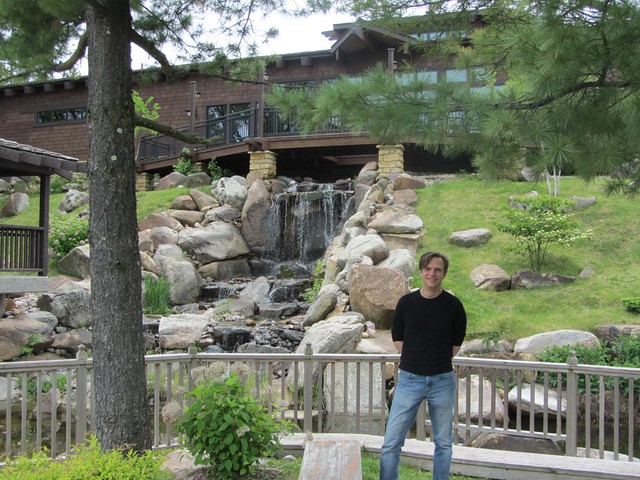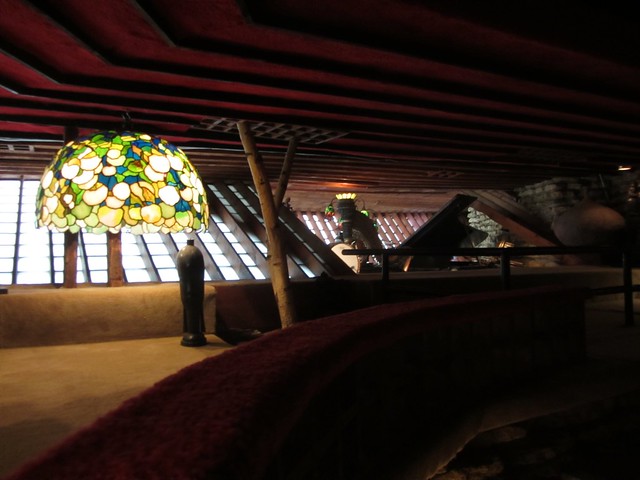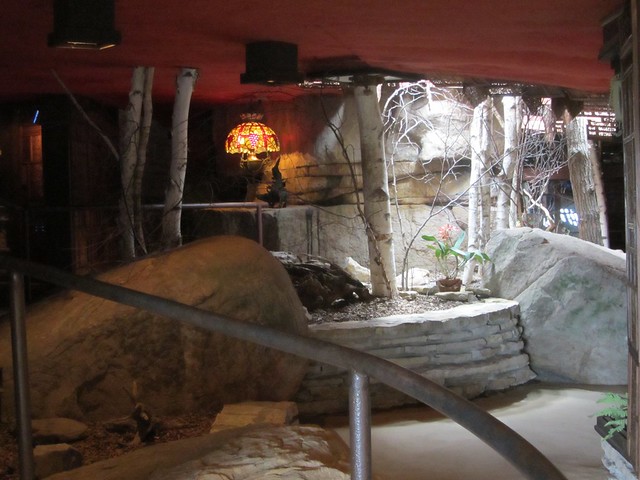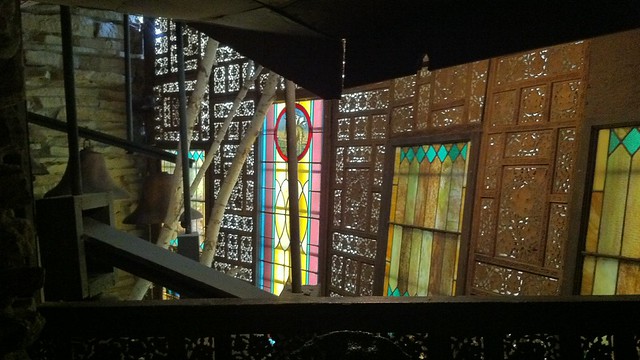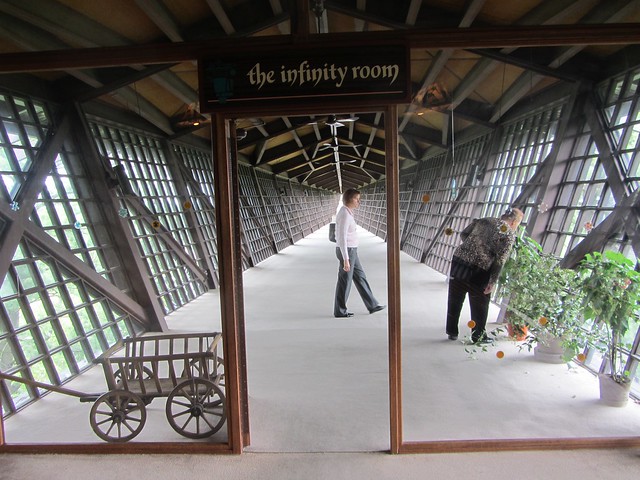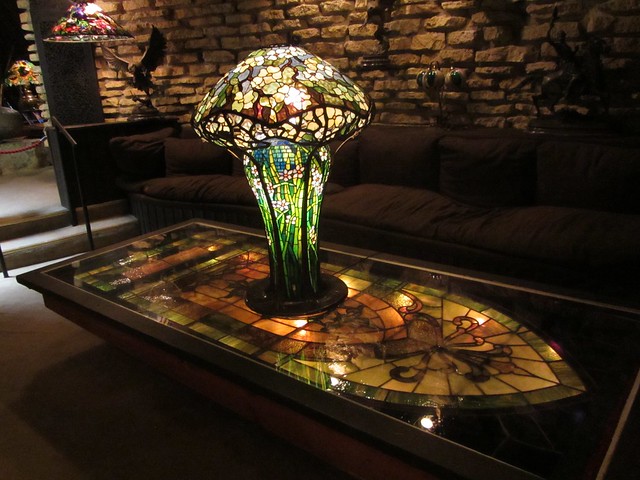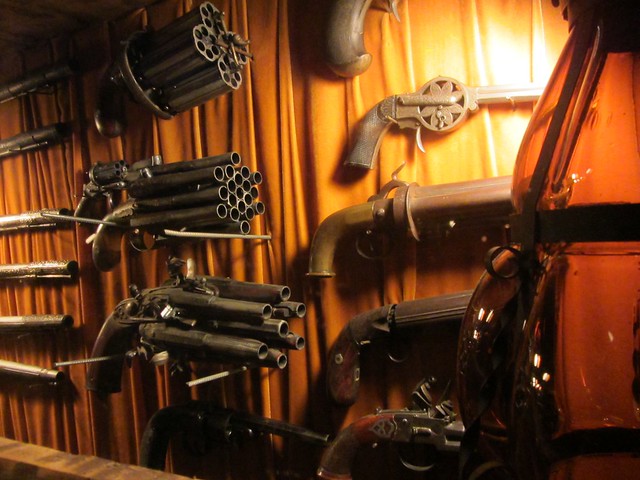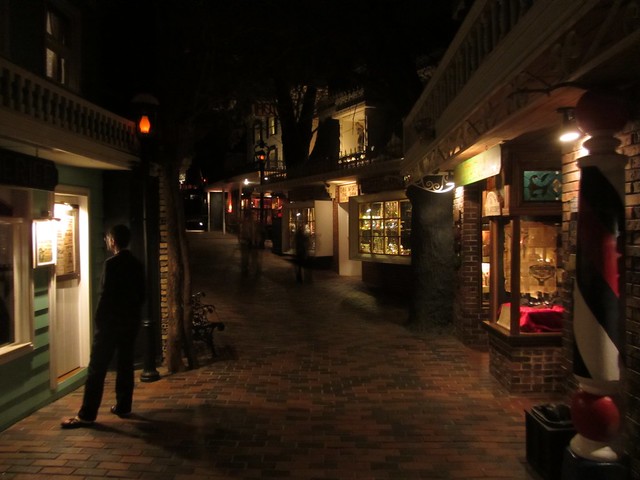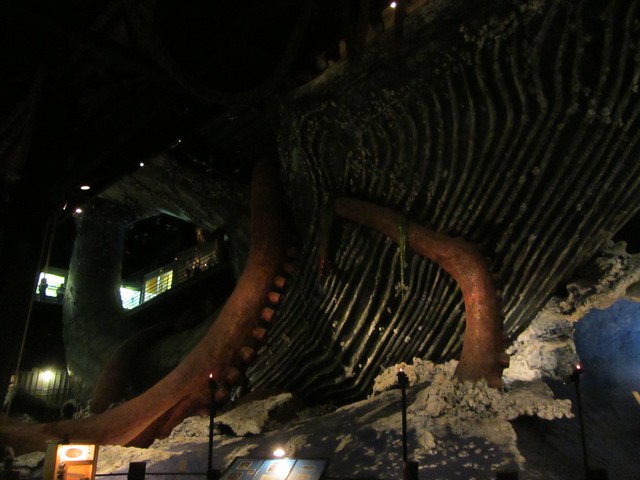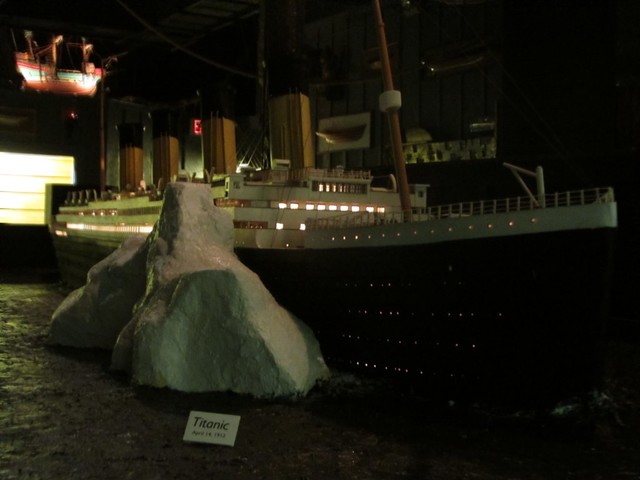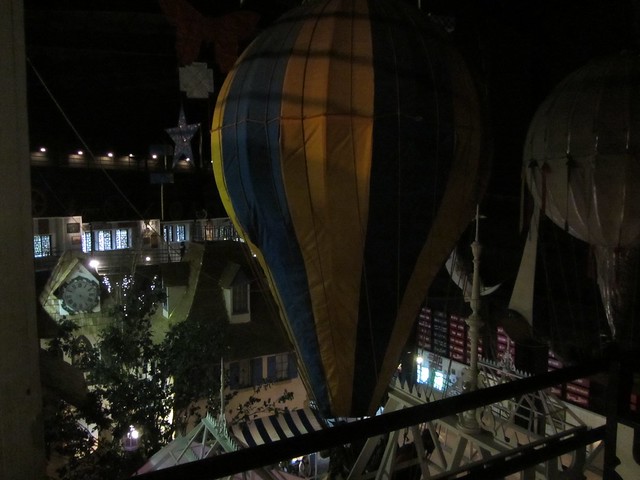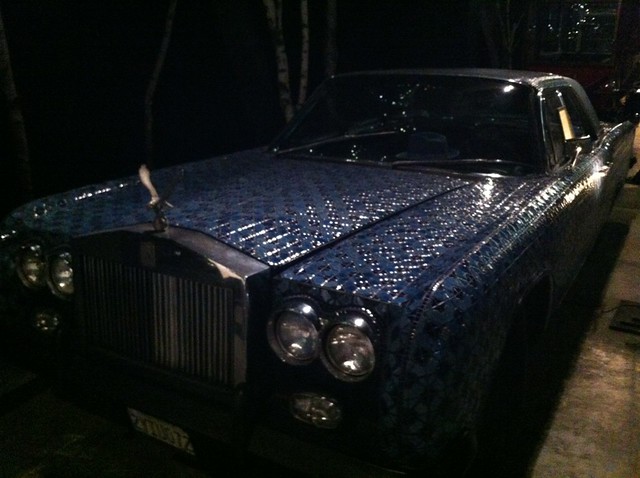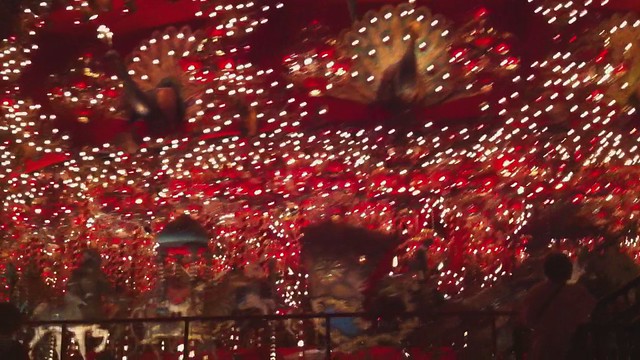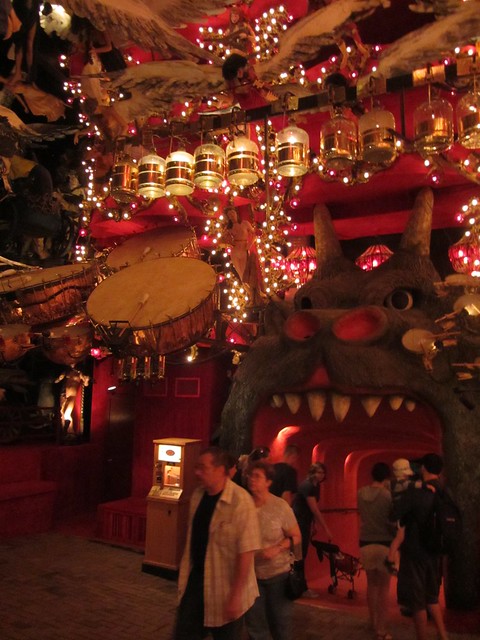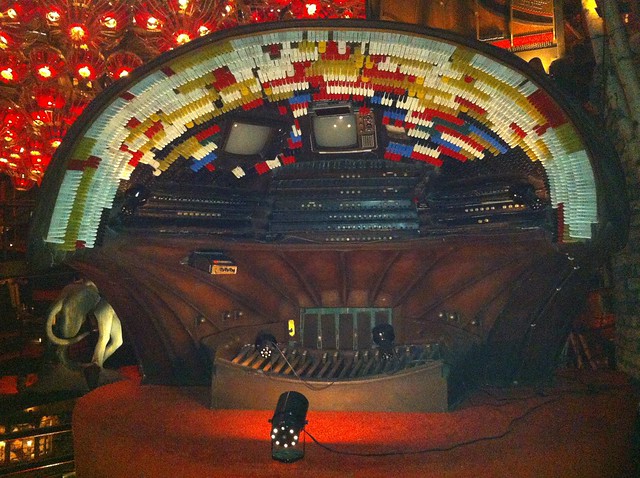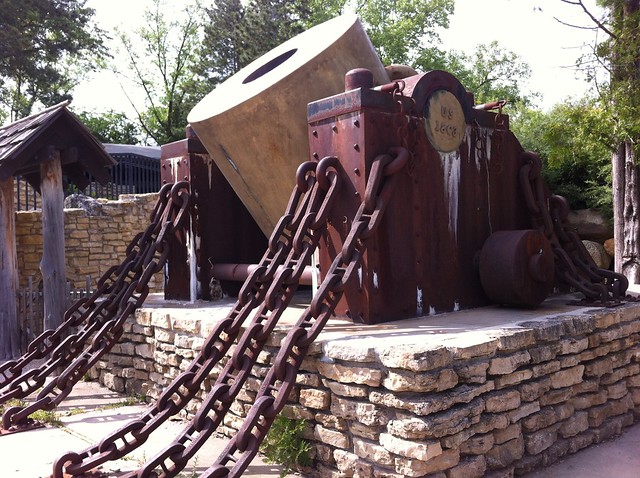In May 2012, my mother-in-law gave us her old car - but we live in Halifax and the car was in Edmonton. So we flew there and drove it all the way back to Halifax. We had great weather and I had a new camera. This is part 9 of a series of blog posts about the trip.
(All of the photos are hosted on Flickr - click on any to see bigger versions and browse the full set.)
It was supposed to be a relaxingly boring day. The last week of driving had featured spectacular mountains and prairie, and we were on our way to several days in the big-city bustle and architectural splendour of downtown Chicago. We had been pleasantly surprised by Wisconsin so far, but we mostly expected the mid-west to provide flat farmland, pretty small towns, and blandly generic cities.
Then, along the main highway, I saw a sign saying "Next Exit: The House on the Rock".
That's a name I remembered from reading Neil Gaiman's "American Gods" - I had initially thought it was a made-up fantasy, but had since heard it was real. We decided to take the exit. Neil Gaiman's fantastical version had seemed flamboyant enough that the real version, even if it wasn't in a magical-realist fantasy novel, would be a nice distraction from the blandness of the interstate.
We entered through a new and spacious visitor centre, with a gift shop and bus-tour-scaled bathrooms, scattered about with model ships and airplanes and vintage dolls. I had heard that model vehicles and dolls had been among the collecting interests of the man behind the House on the Rock, Alex Jordan, Jr.
The visitor centre has a small exhibit about Alex Jordan. He struck me as a distinctly Ayn Rand-style mid-century figure: a visionary individualist who built his own reality alone with his own hands. Legend has it he designed and then built the entire house by himself, bringing every stone and plank up the hillside and fitting them all together entirely on his own. Like most Rand-like übermenchen, though, this is likely more myth than reality. That said, he was definitely an individual with a distinct vision and the financial and personal means to implement it - and as an only-child software developer Apple fan who spent his teenage years really into Rush, I can't deny that this is appealing.
After the exhibit, we entered the House proper. Tickets were available for individual sections or for the whole place. We figured this might be our only time here, so we got the full package. It's a house - how much could there really be?
Going through the House on the Rock is a bit like going through an Ikea: there's one path to follow that takes you through everything. We started in a pleasant Japanese-style garden with a scenic bridge and koi fish. There was a huge fossilized egg, helpfully labeled as "From the Age of the Dinosaurs" - museum-grade research and authenticity clearly wasn't much of a priority in this place.
We quite liked the House itself. It managed to have interesting Modernist shapes while also keeping a kind of Victorian busyness and clutter. Sometimes it looked like a Japanese pagoda, sometimes like a Frank Lloyd Wright house, sometimes an Escher print, sometimes a James Bond villain's lair.
It mixed natural stone with lots of dark wood, stained glass and occasional surprise skylights.
We especially liked the three-storey-high bookcase as well as the intricately carved wooden window shades that reminded me a bit of the ones in the Topkapi palace in Istanbul.
The highlight of the main House is the Infinity Room. It's a long glass-enclosed pier that stretches 100 meters out from the house, far above the Wisconsin treetops below. It's already an engineering feat in how far it sticks out without extra supports, but it's also a trompe-l'oeuil, tapered so that if you're standing in the house it looks like it goes out into the sky for miles.
As you come back into the house from the Infinity Room, there's an intriguing little display:
A recess in the wall, surrounded by overwrought neoclassical detailing, containing two guitars hooked up with various plucking and fretting mechanisms and several tambourines attached to automatic drumsticks. Put in a token and the ingenious automaton starts up and plays a little song. Neat!
This device turned out to be just a tiny foreshadowing of what was clearly a huge obsession of Alex Jordan's. Little did we know that there would be more of this kind of thing further along.
A lot more.
But first we went through the rest of the house, featuring more little musical automata and ersatz Tiffany lamps that looked like mushrooms.
Then we went through a rocky tunnel and emerged above a Hall of Weapons, with many suits of armour and a whole lot of odd-looking multi-barrelled handguns (which were presumably more intimidating than effective).
Everything was interesting but nothing was labelled very much or very well, and I gradually realized that The House on the Rock is just a giant Wunderkammer: a cabinet of curiosities, an eccentric collection of just plain cool stuff. Now that I understood what was going on, I wondered how much more of this there was.
After the weapons, we entered what seemed to be a night-time replica of the Main Street of a 19th century village. Each storefront had its own theme: coffee machines, creepy dolls, firefighting gear, lurid posters, vintage mannequin automata, and more. This was cool and we enjoyed lingering over the stained glass and quirky storefronts, trying to imagine ourselves in a real village.
This hall finished with a collection of massive steam-powered tractors, like wheeled land locomotives.
A small door with a small sign saying "The Heritage of the Sea" (you can see it in the picture above) led us into a refreshingly low-ceilinged hallway lined with display cases of elaborate scrimshaw and pretty model ships. At the far end of the room was a cool model of a giant squid attacking a large whale. It was really impressive, even shrunk down into a window display.
Turns out it was just the planning model for the life-sized version in the next room.
The two leviathans loomed four storeys high in the darkness, grappled in mortal combat while papier-maché waves crashing against the dimly-lit gangplanks surrounding them. The hangar-sized hall was lined with window displays featuring a huge and varied collection of model ships, narwhal bones, preserved sea creatures, and everything else "nautical". There was a huge model of the battleship USS Wisconsin (natch), and an even bigger one of the Titanic, just at the moment that it hit the iceberg.
This is the room that started to wear us down. But there was a lot more to go. The way out led us into another low-ceilinged hallway that featured a huge gold-filigreed carriage that might have belonged to an 18th century aristocrat. We found this comfortingly mundane.
After climbing several ramps we emerged just below the ceiling of another warehouse-sized space, filled with dirigibles and hot-air balloons, all disconcertingly below us. It also smelled strongly of pizza. Very little was surprising to us anymore, so we just took it in stride.
One wall featured a collection of Burma Shave signs, another featured a big blinkenlights device. There was a gorgeous vintage Mercedes. There was also a Lincoln that had been entirely encased in ceramic tile.
Because of course.
I'm a big aviation buff and I enjoyed the small side exhibit featuring model planes and aviation-themed news items. I can easily imagine that Alex Jordan admired Howard Hughes.
But these rooms had turned out to be mere aperitifs. We then passed into a series of chambers devoted to Alex Jordan's real love: automata. Passing by a window full of antique espresso machines, we then entered chamber after themed chamber of giant robotic musical ensembles. There was a Classical room playing Eine Kleine Nachtmusik under blacklight. There was a room full of self-playing sitars. There was a red-lit "Oriental" room full of plaster dragons and flamboyant lamps and detuned violins, which I found kind of embarrassing, but the bus-load of elderly Asian tourists in there with me seemed to enjoy it - perhaps due to its sheer overwrought audacity?
The thing with these automata is that while the drums seemed to be actually making real sounds and the bows and stop mechanisms were moving over the stringed instruments, the resulting strings sounded a whole lot like a lightly-chorused E-MU Proteus string sample - something that might have sounded convincing several decades ago, but which in 2012 sounded clearly artificial.
The Hall of Music finished at a massive music space. This is the room that Neil Gaiman featured in his fantasy novel. This is the place where fantasy becomes reality. This is the ultimate chamber of wonders. This is the Carousel.
The back end of the room is full of stuffed Llamas and massive steam-powered land-tractors, all scattered about with Christmas lights. The ceiling is covered in store mannequins dressed as winged angels, all playing instruments. One entire end of the room features the carousel, so big that only half of it shows. Mere horses and carriages would be too mundane for this Merry-Go-Round - every single creature and float on this is something fantastical: centaurs in full armour, giant sea-horses, mermaids pulling massive scallop-shells, etc. etc. etc.
In Neil Gaiman's "American Gods", the rear of this merry-go-round connects directly to the mind of the All-Father. In the non-Magical-Realist world, it's still uncannily spectacular. It's an entire room devoted to semi-automated music. As elsewhere, though, the drums seem to be authentic, but the strings seem synthesized, much as the physical devices pretend to press on the proper stops.
What puts this over the top is that the music is slightly out of tune and the mechanized drums beat slightly out of time, tipping the experience away from whimsy and well into nightmare territory.
Neil Gaiman certainly called it: if there's a spiritual mystical kitschy heart to this part of Wisconsin, then the carousel at the House on the Rock is the centre of it.
The carousel is the end of part II of the tour. We had bought the whole package, so, unbelievably there was still more to go. The path to the rest of the complex was through a gateway framed by a horned demonic face.
By this point we were getting over-stimulated. We knew we had to make it through the rest of the exhibits, but we also noticed that while there were plenty of emergency exits, there weren't (unlike Ikea) any shortcuts.
We grimly realized that to get out of here we would have to go through all of the remaining exhibits. Our jaws were set. Our Nietszchean wills were wearily ready. We pushed onward.
We found ourselves in a giant warehouse with one half devoted to brass and copper brewery implements and the other half filled with huge latter-day electric organs, complete with massive consoles and even more massive sound tubes.
We rushed through, not daring to linger too long lest we be driven mad like some weak-minded victim in an H.P. Lovecraft novella.
We briefly found ourselves in an unused cafeteria, with a door that lead outside. The fresh air and sunshine made an inviting respite. There were even butterflies. Above us we could see the Infinity Room jutting out into the sky. It seemed so far away and our time there from so long ago. Back then, we had lingered over every exhibit and curiosity. Now, we were doggedly pushing onward.
The House on the Rock struck back immediately: we were confronted with a massive musical automaton recreating an entire marching band on three stacked platforms. Behind it was a full-sized orchestra and a plaque noting that it was the largest musical automaton in the world. We pooled our remaining tokens, pushed the button on the little console, and watched several minutes of swinging arms and torsos and the uncanny combination of synthesized strings and off-kilter percussion.
We started to panic. We were no longer interested in the exhibits - we just wanted to get out. The only exits seemed to be emergency exits which would trigger alarms, so we had to keep going through the official path.
We left the organs behind and passed into endless corridors of 19th-century dolls and dollhouses. They were lovely but overwhelming, like a warehouse of Kinkade paintings made real.
Finally we reached open air - a side courtyard attached to the park we had passed through at the beginning of our tour, which seemed like a lifetime ago. The dominant feature was a massive siege mortar from the Civil War era.
Any other time, this would have been a fascinating curiosity, but we barely noticed it.
Past that, we found an empty concrete wall - the first brightly lit, non-cluttered surface we had seen in hours.
At the end of all of this Randian madness was, of course, a gift shop. There was fudge. And Coffee mugs. I bought some of both. I still use the mug almost daily, as a companion to my Apple mug - starting my morning with two signifiers of mad independent genius.
Random Thoughts
- I suspect that Alex Jordan wanted the House on the Rock to feel a bit like Disneyland. Instead, it feels a lot more like Rapture from BioShock - dark and busy and modernist and half-mad.
- In a way, the House on the Rock is like the Internet, especially its more OCD/ADHD corners like BoingBoing, Reddit, or 4chan: lots of attention-grabbing eccentricity with varying levels of provenance. Except it's like you can't go to another page until you've finished reading every comment and viewing every doctored photograph on the current one.
- What makes The House on the Rock extra striking is that it's surrounded by miles of Wisconsin farmland. I'm not sure whether it would have the same effect if it was in the middle of, say, Las Vegas. On the other hand, I think its particular madness is tuned to the mid-western work ethic. The place is nothing if not thorough, and it was grown over the years like a prize crop.
- Part of the message seems to be: the same kind of hard work you do as a Farmer can also make you a Genius.
- While in the House, I was annoyed at the faked music as much as at the lack of rigour in the curation of the artifacts, but since then I've found them all to be essential parts of the full experience of the House on the Rock.
I've realized that The House on the Rock is a Show: a Show built on the ideal of a mad Randian genius targeted at the can-do Midwest. It projects itself as a temple to the Fascinating, it's crammed full of unique artifacts and it's a place where machines sing and play in perfect harmony. The fact that the artifacts might be faked, and that the machines don't sing without some piped-in autotune is irrelevant to the magic, and perhaps even makes it better.
